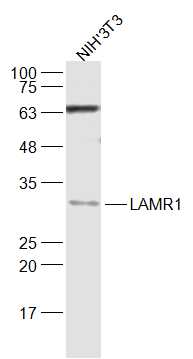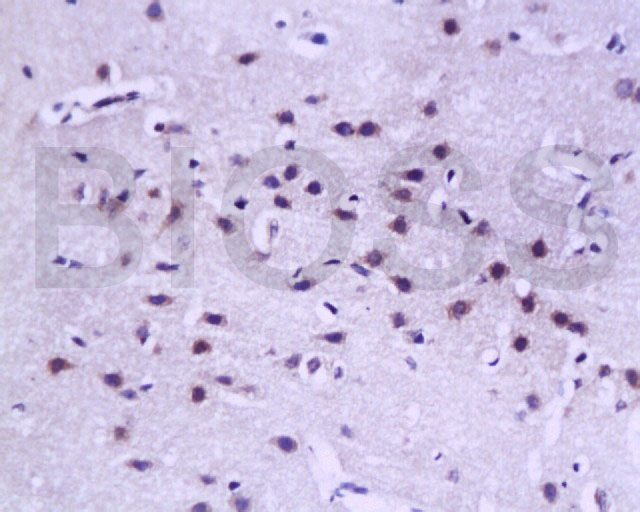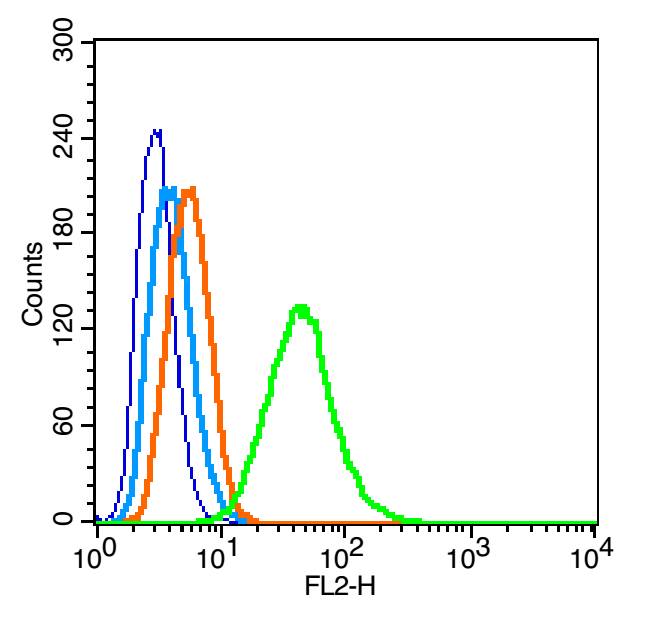
Rabbit Anti-RPSA antibody
67kDa Laminin Receptor; 37LRP; P37-kDa laminin receptor precursor; MGr1-Ag; laminin receptor 1; 67kD, ribosomal protein SA; 34/67 kDa laminin receptor; 40S ribosomal protein SA; 67LR; Colon carcinoma laminin-binding protein; LAMBR; Laminin Receptor 1; LAM
View History [Clear]
Details
Product Name RPSA Chinese Name 层粘连蛋白受体1抗体 Alias 67kDa Laminin Receptor; 37LRP; P37-kDa laminin receptor precursor; MGr1-Ag; laminin receptor 1; 67kD, ribosomal protein SA; 34/67 kDa laminin receptor; 40S ribosomal protein SA; 67LR; Colon carcinoma laminin-binding protein; LAMBR; Laminin Receptor 1; LAMR 1; LAMR1; LRP; Multidrug resistance-associated protein MGr1-Ag; NEM/1CHD4; p40; Ribosomal Protein SA; 67kD laminin receptor; Laminin Receptor 1; Laminin R1; LNR1; RSSA_HUMAN. literatures Research Area Tumour Apoptosis The cell membrane受体 Immunogen Species Rabbit Clonality Polyclonal React Species Mouse, Rat, (predicted: Human, Dog, ) Applications WB=1:500-2000 ELISA=1:5000-10000 IHC-P=1:100-500 IHC-F=1:100-500 Flow-Cyt=1μg/Test IF=1:100-500 (Paraffin sections need antigen repair)
not yet tested in other applications.
optimal dilutions/concentrations should be determined by the end user.Theoretical molecular weight 32.7/67kDa Cellular localization The nucleus cytoplasmic The cell membrane Extracellular matrix Form Liquid Concentration 1mg/ml immunogen KLH conjugated synthetic peptide derived from human LAMR1: 201-295/295 Lsotype IgG Purification affinity purified by Protein A Buffer Solution 0.01M TBS(pH7.4) with 1% BSA, 0.03% Proclin300 and 50% Glycerol. Storage Shipped at 4℃. Store at -20 °C for one year. Avoid repeated freeze/thaw cycles. Attention This product as supplied is intended for research use only, not for use in human, therapeutic or diagnostic applications. PubMed PubMed Product Detail Laminins, a family of extracellular matrix glycoproteins, are the major noncollagenous constituent of basement membranes. They have been implicated in a wide variety of biological processes including cell adhesion, differentiation, migration, signaling, neurite outgrowth and metastasis. Many of the effects of laminin are mediated through interactions with cell surface receptors. These receptors include members of the integrin family, as well as non-integrin laminin-binding proteins. This gene encodes a high-affinity, non-integrin family, laminin receptor 1. This receptor has been variously called 67 kD laminin receptor, 37 kD laminin receptor precursor (37LRP) and p40 ribosome-associated protein. The amino acid sequence of laminin receptor 1 is highly conserved through evolution, suggesting a key biological function. It has been observed that the level of the laminin receptor transcript is higher in colon carcinoma tissue and lung cancer cell line than their normal counterparts. Also, there is a correlation between the upregulation of this polypeptide in cancer cells and their invasive and metastatic phenotype. Multiple copies of this gene exist, however, most of them are pseudogenes thought to have arisen from retropositional events. Two alternatively spliced transcript variants encoding the same protein have been found for this gene.
Function:
Required for the assembly and/or stability of the 40S ribosomal subunit. Required for the processing of the 20S rRNA-precursor to mature 18S rRNA in a late step of the maturation of 40S ribosomal subunits. Also functions as a cell surface receptor for laminin. Plays a role in cell adhesion to the basement membrane and in the consequent activation of signaling transduction pathways. May play a role in cell fate determination and tissue morphogenesis. Acts as a PPP1R16B-dependent substrate of PPP1CA. Also acts as a receptor for several other ligands, including the pathogenic prion protein, viruses, and bacteria.
Subunit:
Monomer (37LRP) and homodimer (67LR). Component of the small ribosomal subunit. Mature ribosomes consist of a small (40S) and a large (60S) subunit. The 40S subunit contains about 33 different proteins and 1 molecule of RNA (18S). The 60S subunit contains about 49 different proteins and 3 molecules of RNA (28S, 5.8S and 5S). Interacts with RPS21. Interacts with several laminins including at least LAMB1. Interacts with MDK. Interacts with PRNP. The mature dimeric form interacts with PPP1R16B (via its fourth ankyrin repeat). Interacts with PPP1CA only in the presence of PPP1R16B.
Subcellular Location:
Cell membrane. Cytoplasm. Nucleus. 67LR is found at the surface of the plasma membrane, with its C-terminal laminin-binding domain accessible to extracellular ligands. 37LRP is found at the cell surface, in the cytoplasm and in the nucleus (By similarity). Co-localizes with PPP1R16B in the cell membrane.
Post-translational modifications:
Acylated. Acylation may be a prerequisite for conversion of the monomeric 37 kDa laminin receptor precursor (37LRP) to the mature dimeric 67 kDa laminin receptor (67LR), and may provide a mechanism for membrane association.
Cleaved by stromelysin-3 (ST3) at the cell surface. Cleavage by stromelysin-3 may be a mechanism to alter cell-extracellular matrix interactions.
Similarity:
Belongs to the ribosomal protein S2P family.
SWISS:
P08865
Gene ID:
3921
Database links:Entrez Gene: 3921 Human
Entrez Gene: 100505031 Mouse
Entrez Gene: 16785 Mouse
Omim: 150370 Human
SwissProt: P08865 Human
SwissProt: P14206 Mouse
Unigene: 449909 Human
Unigene: 311972 Mouse
Unigene: 391708 Mouse
Unigene: 4071 Mouse
Unigene: 121972 Rat
Unigene: 161973 Rat
Unigene: 999 Rat
层粘连蛋白受体1(37LRP)为分子量67KDa层粘连蛋白受体重要的前体.是近期发现的-胃癌耐药相关蛋白.Product Picture
NIH/3T3(Mouse) Cell Lysate at 30 ug
Primary: Anti-LAMR1 (SL0901R) at 1/1000 dilution
Secondary: IRDye800CW Goat Anti-Rabbit IgG at 1/20000 dilution
Predicted band size: 32.7/67 kD
Observed band size: 32.7 kD
Tissue/cell: rat brain tissue; 4% Paraformaldehyde-fixed and paraffin-embedded;
Antigen retrieval: citrate buffer ( 0.01M, pH 6.0 ), Boiling bathing for 15min; Block endogenous peroxidase by 3% Hydrogen peroxide for 30min; Blocking buffer (normal goat serum,C-0005) at 37℃ for 20 min;
Incubation: Anti-LAMR1(CT) Polyclonal Antibody, Unconjugated(SL0901R) 1:200, overnight at 4°C, followed by conjugation to the secondary antibody(SP-0023) and DAB(C-0010) staining
Blank control: RSC96(blue), the cells were fixed with 2% paraformaldehyde (10 min) and then permeabilized with ice-cold 90% methanol for 30 min on ice.
Isotype Control Antibody: Rabbit IgG(orange) ; Secondary Antibody: Goat anti-rabbit IgG-PE(white blue), Dilution: 1:200 in 1 X PBS containing 0.5% BSA ; Primary Antibody Dilution: 0.2μg in 100 μL1X PBS containing 0.5% BSA(green).
Bought notes(bought amounts latest0)
No one bought this product
User Comment(Total0User Comment Num)
- No comment





 +86 571 56623320
+86 571 56623320
 +86 18668110335
+86 18668110335

